Service Request
This documentation is incomplete.
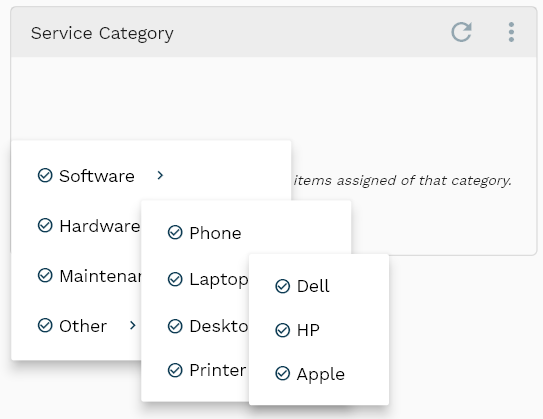
A service request is a request from a user or a user's authorized representative that initiates a procurement process of a new product/service for the user. In other words, a service request is typically raised to procure something the user needs to perform daily activities.
A service request is different from an incident. You create an incident to report the failure of a process or product. However, you make a service request to acquire a new product/service.
Service requests can be created using the service catalog or manually entering all the service request details.
Service catalog simplifies the process for service where a user can request any service with just one click/tap of a button. To use service catalogs, you must create all available standard services and assign them to a service category.
In InoERP, service requests are created at the instance level. However, you can assign a serial number or lot number for customer service requests that indirectly specify the associated inventory organization.
Process Flow
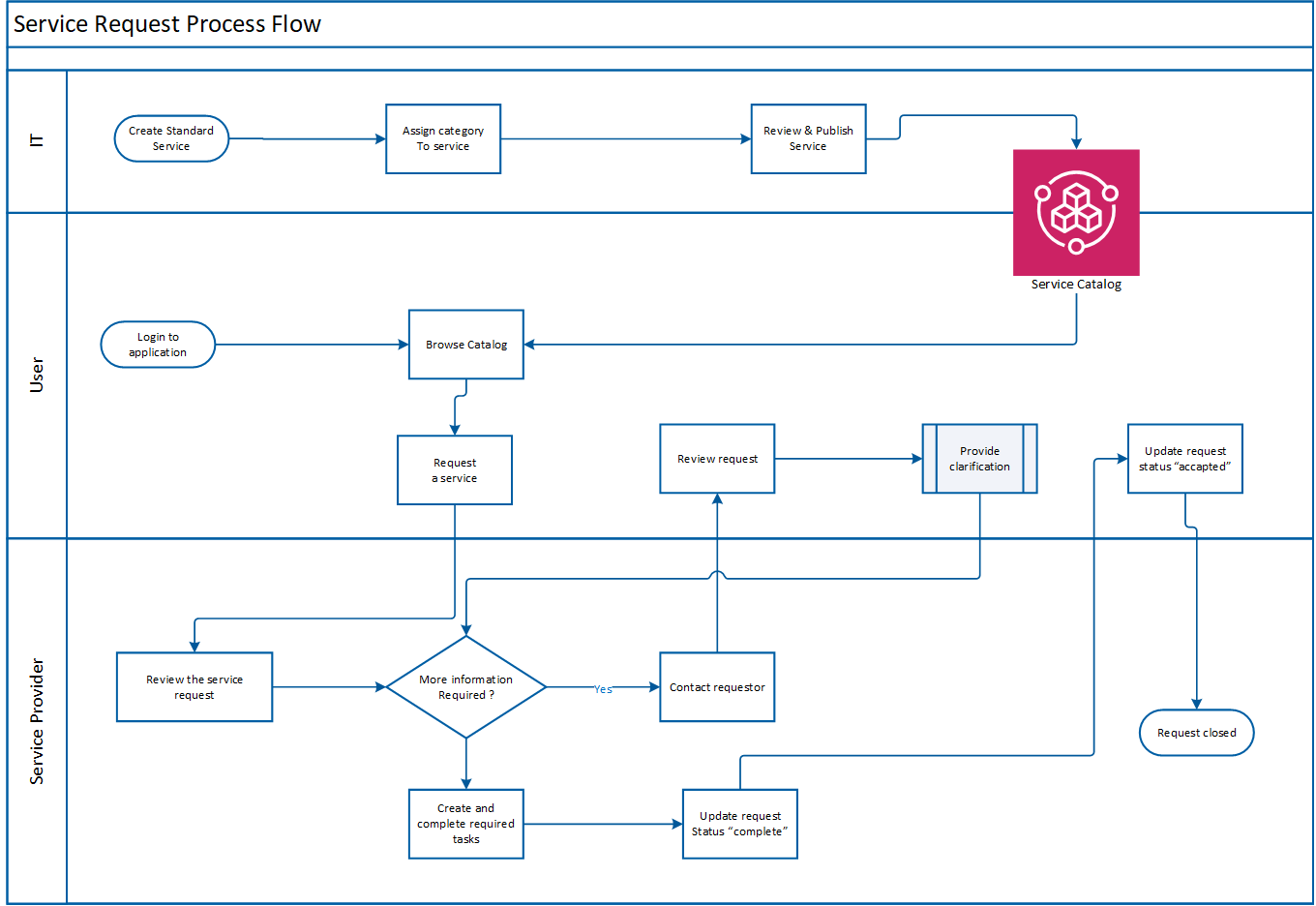
The above process flow is the default process flow for a standard service request. You can customize the process flow depending on the service type and your business needs.
Request Service Using Category
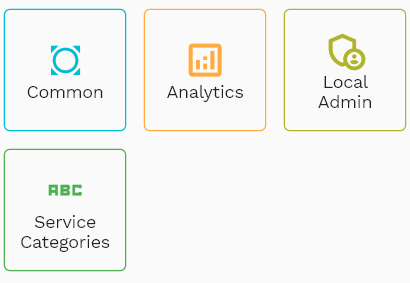
Service requests can be created in different ways.
The easiest option is to use a service catalog. The standard service tab (page) shows three separate sections.
Service category browser:
Shows navigation panel to select a specific service category. Click on any category to view all the services associated with the category. All the services are shown in the right panel (section 3)Latest knowledge base articles: Click on any article description to read the complete article. You can show your company policies related to services in this section.
Standard service requests:
This section shows all the available standard services. When you click on any specific category (in section 1), the system displays only services associated with the particular category in this section.
Navigate to the tabs screen to configure the service category tab as per your business needs.
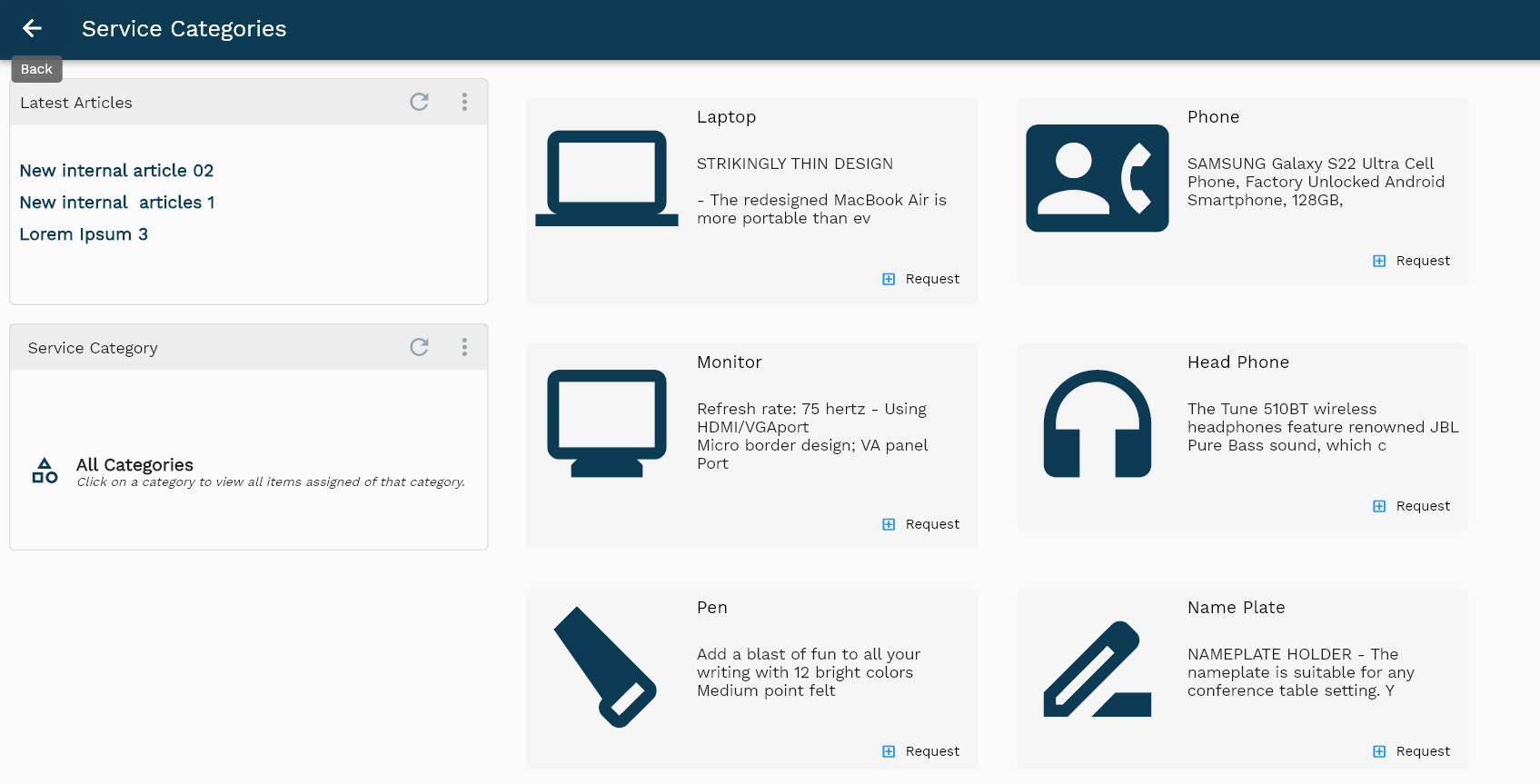
To view the details of a standard service, click on the request button next to a standard service. The system will take you to the detailed page of the standard service.
In the summary screen, the system shows only an icon/image of the standard service and the first few characters of the Description. The screen auto-adjusts all the contents depending on the device size and type.
The default configuration shows four tabs on the detailed screen of a standard service.
Basic tab
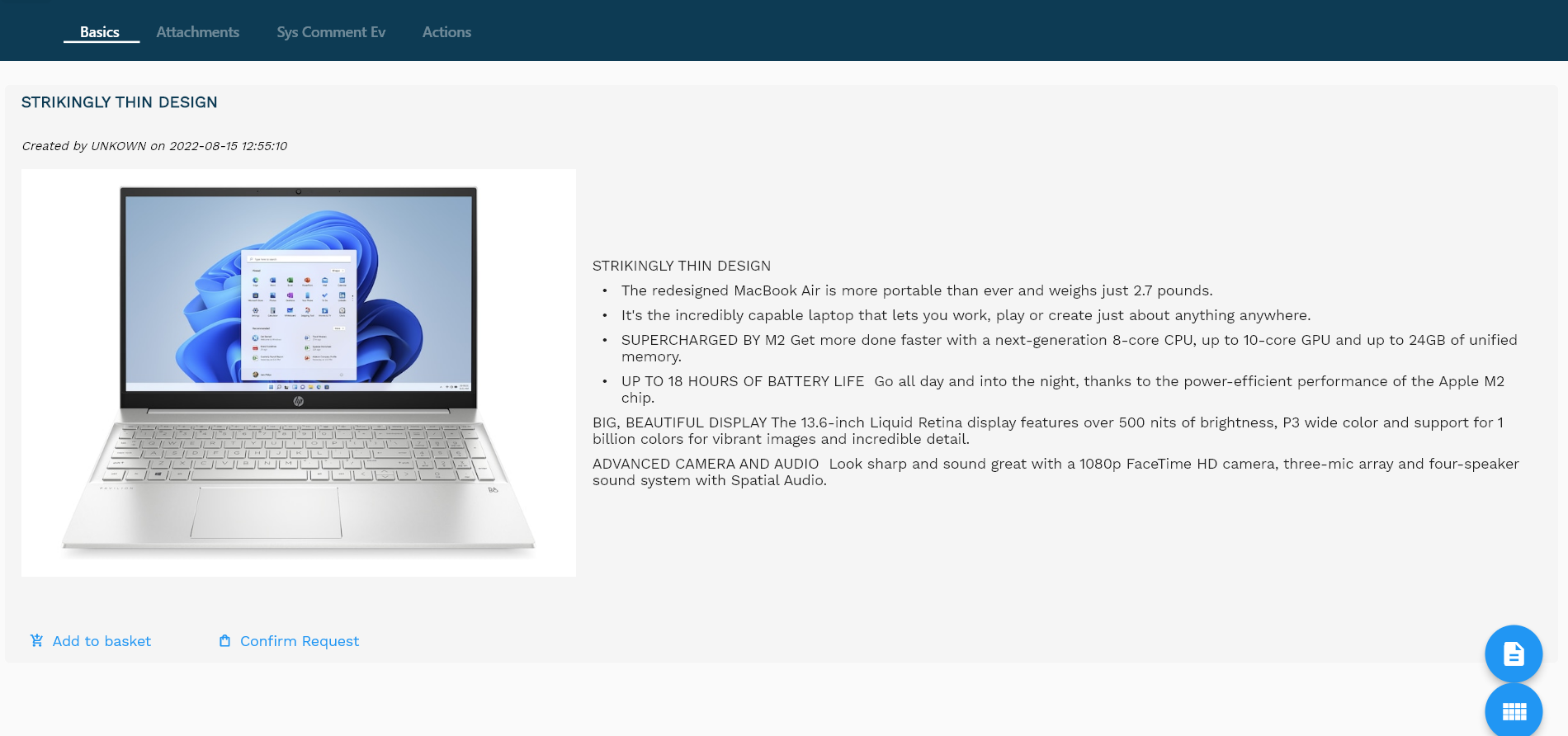
The basic tab shows the service's full Description with associated images and icons.
You can write the contents of the service in simple plain text or in markdown language. The application does not support any other format.
If you have the authority and are required to maintain the standard service, then you can click on the detailed screen icon (bottom right corner) to view the service details in a form.
Click on the confirm request button to create a service request.
The requestor name is a mandatory field to create a service request, and the system defaults the value from the session data. Thus, you must be logged in to the application to make a service request.
If a service request is successfully created, the system will show a message with all the details of the newly created service request, including the request number and id.

Attachment tab
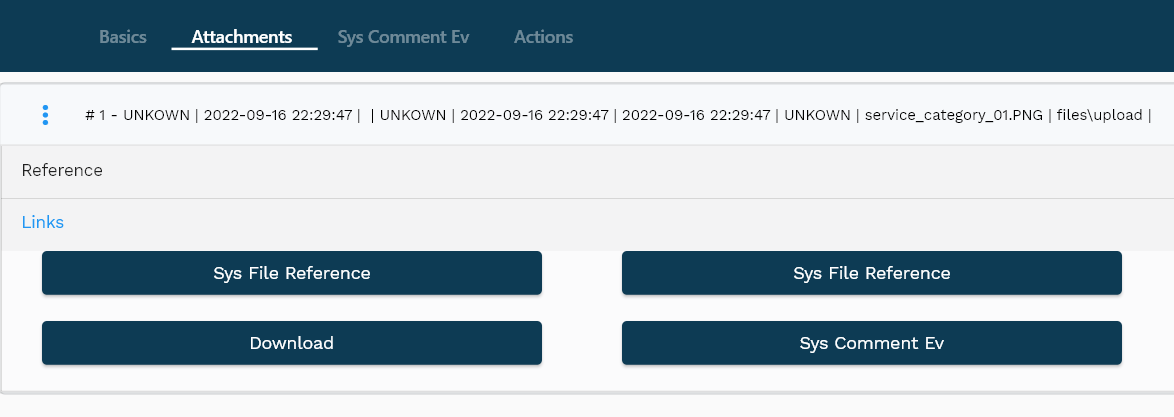
The attachment tab shows all the files attached to the standard service request. You can attach all the related files of the service on this tab. The users can download these files and review them before/after requesting a service.
You can click the download button against a file to download the attachment to your local device. On desktop devices (Windows, Mac, and Linux), the application will download the file and show you an option to open it from the source. In mobile devices, the application stores the file on local storage and tries to open it directly.
Comments tab

The comments section shows all the existing comments created against the standard service. You can create a new service and take the actions below in your comments.
- Update own comment
- Delete your own comment
- Vote against any comment
Actions

Confirm Request:
The application creates a service request for the current user using the standard service. The action is the same as the "confirm request" action on the basic tab.
Copy: The application copies the standard request details to a new standard request.
Manual Service Request

It's advisable to create standard service requests and use the service category browser to create service requests. However, the system allows you to create service requests using the service request screen.
Header
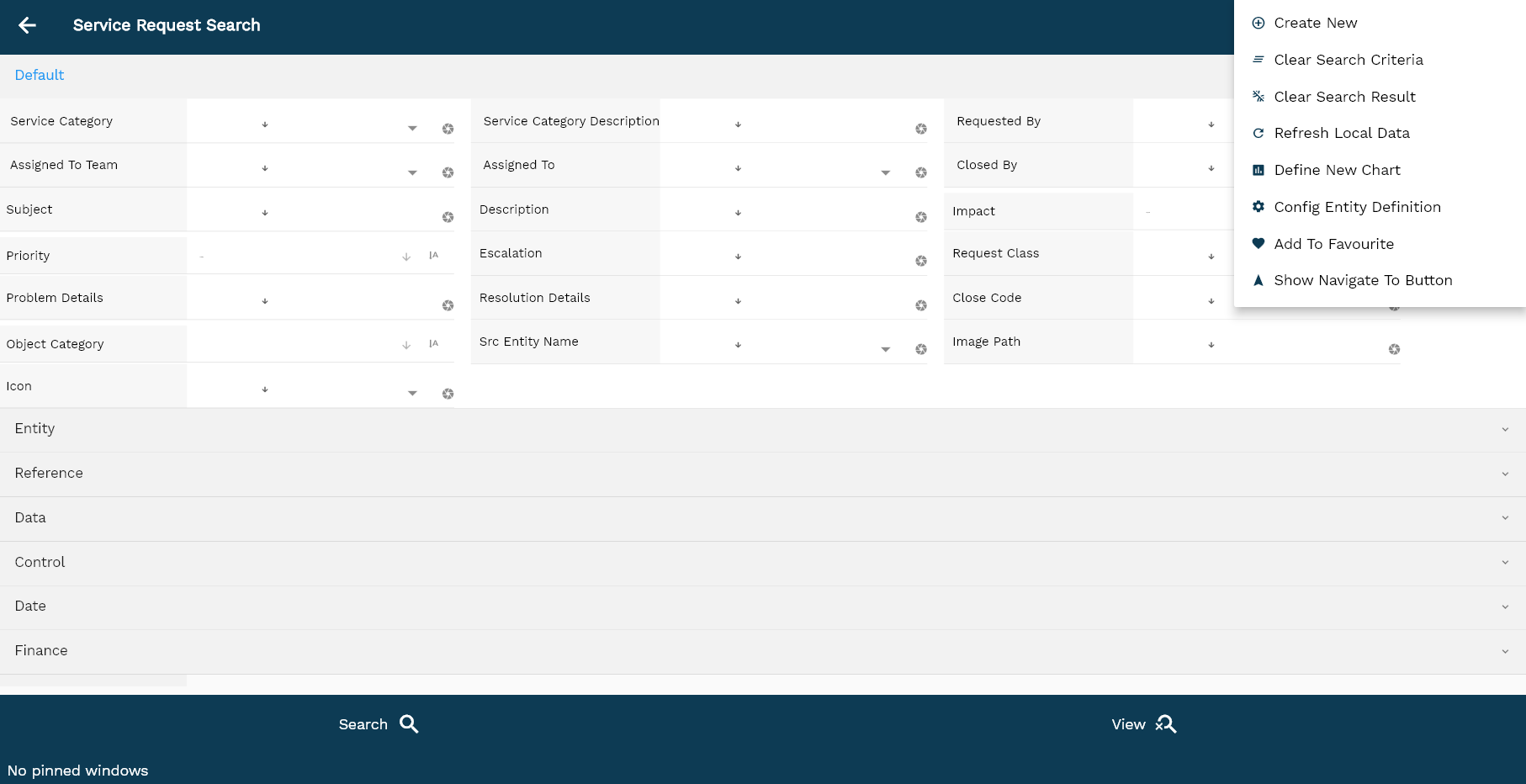
To view/create/update a service request header, navigate to the "service request" search screen from your dashboard/favorite.
Click on create a new button to create a new service request header; by manually entering all the information.
Copying an existing service request header to a new service request header is always better than manually entering all the data to create a new service request header. The application lets you update all the details before confirmation; you can configure which fields are view-only after the confirmation.
Enter the organization/service request header details or any other criteria in the search form and click on the search button to view an existing service request header.

The system will show you all the service request headers if you don't enter organization/request details. If your organization configures any mandatory search field, you must enter those fields to search service request headers.
For the first search of any entity, there is no difference between using the search or view button. The application always fetches data from the server. However, after the first search, if you click the view button, the application will show if any cached result is available on the local device for the same search criteria. If you click the search button, the application will fetch data from the server and take you to the search result screen.
The search result screen looks a bit different on desktop and mobile devices.

To view the search result in a table format, click on the table icon in the bottom left corner.
To open a specific service request header, click on the menu of that record, and click on view/fetch & view.
You can also click on the expand icon against any item on the search result screen to view the service request header details such as service request description, requestor, status, etc.

Service Category: Select a service category from the list of values. Service category defaults team and "assigned to" person
Requested By: If you are creating the request on behalf of a different person, enter the name of the original requestor/service receiver.
Assigned To Team: Select a team that will work on the service request. If your organization uses a triage team to review and assign all service requests, then select the name of the triage team. You can also configure the application to default the value from the service category.
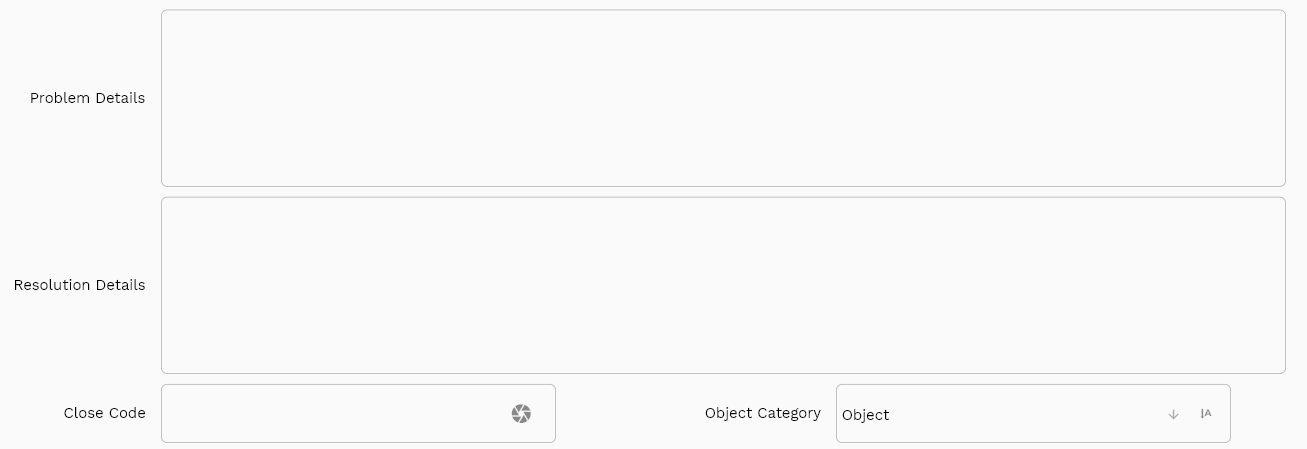
Description: Enter the service's details in the description field. It's a mandatory field and is shown as a multi-line text field. You can use markdown language in this field.
Double-click on the field to view the Description on a larger area, and the application will show the field on a separate popup screen.
Resolution Details: Not required to be entered by the requestor. You can also hide this field by creating a separate view. The team/person who completes the service request can enter the resolution details before completing/closing a service request.

Scroll left, right, up, and down to view all the details. The service request header line and details are shown in a separate tab. The default configuration shows fields in various functional groups, such as
- Finance
- Entity
- Reference
- Data
- Control
- Etc
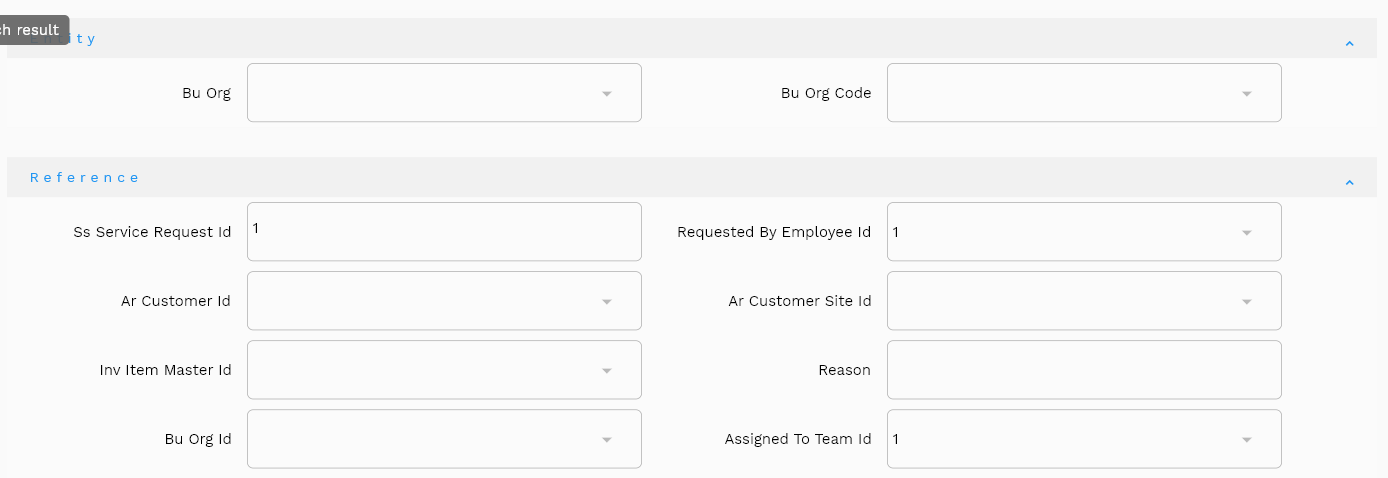
The reference groups show various ids for reference only. You don't need to enter any information in this section. When you save a transaction doc for the first time, the system will auto-populate the newly created header id and line ids.
You can configure the application to show which fields should be under which group. You can also create new groups as per your business requirements.

All Fields
| Name | Sequence | Label | InputType | Field Group |
|---|---|---|---|---|
| 10 | vvServiceCategory | Service Category | defferedSelect | DEFAULT |
| 10 | vvServiceCategoryDescription | Service Category Description | text | DEFAULT |
| 20 | vvAssignedToTeam | Assigned To Team | defferedSelect | DEFAULT |
| 30 | vvAssignedTo | Assigned To | defferedSelect | DEFAULT |
| 40 | vvBuOrg | Bu Org | defferedSelect | ENTITY |
| 50 | vvBuOrgCode | Bu Org Code | defferedSelect | ENTITY |
| 60 | ssStandardRequestId | Ss Standard Request Id | text | REFERENCE |
| 70 | subject | Subject | textField | DEFAULT |
| 80 | description | Description | textField | DEFAULT |
| 90 | requestNumber | Request Number | textField | DATA |
| 100 | arCustomerId | Ar Customer Id | defferedSelect | REFERENCE |
| 110 | arCustomerSiteId | Ar Customer Site Id | defferedSelect | REFERENCE |
| 120 | invSerialNumberId | Inv Serial Number Id | defferedSelect | DATA |
| 130 | invItemMasterId | Inv Item Master Id | defferedSelect | REFERENCE |
| 140 | impact | Impact | select | DEFAULT |
| 150 | priority | Priority | select | DEFAULT |
| 160 | reason | Reason | text | REFERENCE |
| 170 | escalation | Escalation | textField | DEFAULT |
| 190 | requestType | Request Type | textField | CONTROL |
| 200 | requestClass | Request Class | textField | DEFAULT |
| 210 | buOrgId | Bu Org Id | defferedSelect | REFERENCE |
| 220 | assignedToTeamId | Assigned To Team Id | defferedSelect | REFERENCE |
| 230 | assignedToEmployeeId | Assigned To Employee Id | defferedSelect | REFERENCE |
| 240 | objectCategory | Object Category | select | DEFAULT |
| 250 | srcEntityName | Src Entity Name | defferedSelect | DEFAULT |
| 260 | srcEntityId | Src Entity Id | text | REFERENCE |
| 270 | ssRequestCategoryId | Ss Request Category Id | text | REFERENCE |
| 280 | mdmCategoryId | Mdm Category Id | defferedSelect | REFERENCE |
| 290 | imagePath | Image Path | textField | DEFAULT |
| 300 | invLotNumberId | Inv Lot Number Id | defferedSelect | DATA |
| 310 | costBudget | Cost Budget | textField | FINANCE |
| 320 | icon | Icon | deferredSelect | DEFAULT |
| 5180 | docStatus | Doc Status | text | CONTROL |
| 5330 | createdBy | Created By | text | REFERENCE |
| 5340 | creationDate | Creation Date | text | REFERENCE |
| 5360 | lastUpdateDate | Last Update Date | text | REFERENCE |
| 10350 | lastUpdatedBy | Last Updated By | text | REFERENCE |
Task
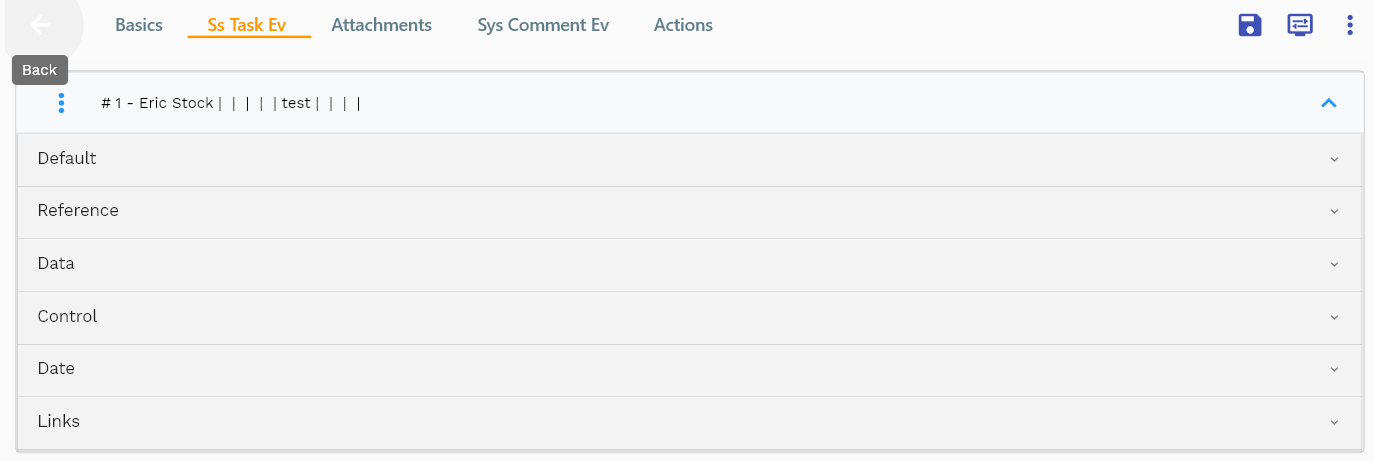
Service request tasks specify all the tasks that must be completed to complete a service request. The system can automatically generate/update the service request tasks for standard services. However, the system allows you to create/update/delete service request tasks.
Each task represents a specific unit of work and is assigned to a single team and to a particular employee who takes ownership of the task.
You can add multiple lines(service request tasks) to each service request header.

Navigate to the lines tab to view/add/update lines.
Click on the add new entity to add a new line. If a line already exists, click on copy entity to copy all the details.
You can enable/disable fields allowed to be copied in the menu configuration.

Requested By: If you are creating the task on behalf of a different person, enter the original requestor's name.
Assigned To Team: Select a team that will work on the service task. Select the triage team's name if your organization uses a triage team to review and assign all service tasks.
Description: Enter the task details in the description field. It's a mandatory field and is shown as a multi-line text field.
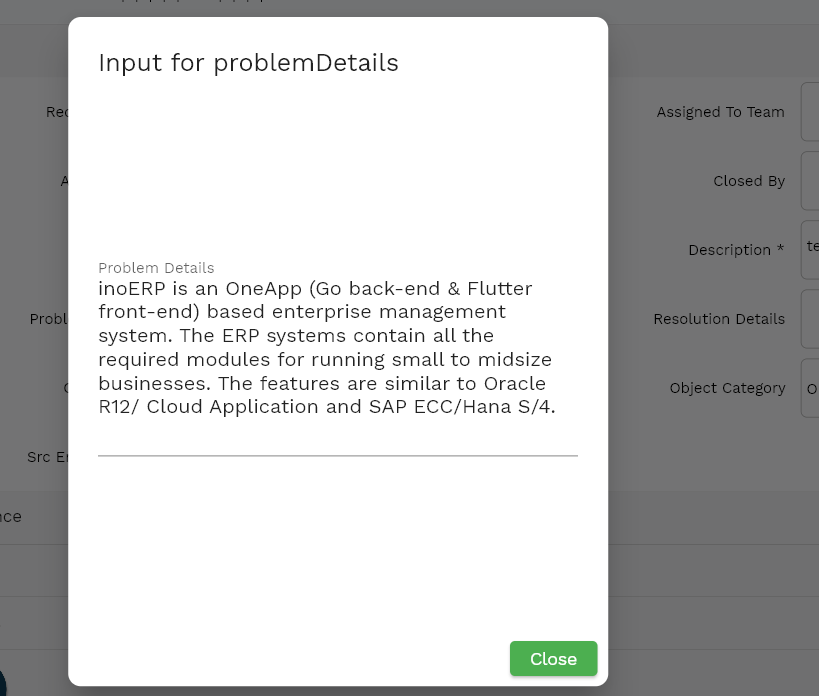
Problem Details: You can enter the task details and the problem it's trying to resolve in the problem details field. The field is shown as a multi-line text field and supports markdown language.
The reference groups show various ids for reference only. You don't need to enter any information in this section. When you save a service request header for the first time, the system will auto-populate the newly created header id and line ids.
Scroll left, right, up, and down to view all the details. The default configuration shows fields in various functional groups, such as
- Finance
- Entity
- Reference
- Data
- Control
- Etc
Enter all the other fields and click the save button to save the service request header. The app will post all the data to the server and show you returned message from the server.

All Fields
| Name | Sequence | Label | InputType | Field Group |
|---|---|---|---|---|
| 10 | vvRequestedBy | Requested By | defferedSelect | DEFAULT |
| 10 | vvAssignedToTeam | Assigned To Team | defferedSelect | DEFAULT |
| 20 | vvAssignedTo | Assigned To | defferedSelect | DEFAULT |
| 30 | vvClosedBy | Closed By | defferedSelect | DEFAULT |
| 40 | ssTaskId | Ss Task Id | text | REFERENCE |
| 50 | requestedByEmployeeId | Requested By Employee Id | defferedSelect | REFERENCE |
| 60 | subject | Subject | largeText | DEFAULT |
| 70 | description | Description | textArea | DEFAULT |
| 80 | taskNumber | Task Number | textField | DATA |
| 90 | reason | Reason | text | REFERENCE |
| 100 | ssServiceRequestId | Ss Service Request Id | text | REFERENCE |
| 110 | ssIncidentId | Ss Incident Id | text | REFERENCE |
| 120 | ssStandardRequestId | Ss Standard Request Id | text | REFERENCE |
| 140 | taskType | Task Type | textField | CONTROL |
| 150 | problemDetails | Problem Details | textArea | DEFAULT |
| 160 | resolutionDetails | Resolution Details | textArea | DEFAULT |
| 170 | hdChangeRequestId | Hd Change Request Id | text | REFERENCE |
| 180 | closeCode | Close Code | textField | DEFAULT |
| 190 | objectCategory | Object Category | select | DEFAULT |
| 200 | closedByEmployeeId | Closed By Employee Id | defferedSelect | REFERENCE |
| 210 | closedDate | Closed Date | date | DATE |
| 220 | assignedToTeamId | Assigned To Team Id | defferedSelect | REFERENCE |
| 230 | assignedToEmployeeId | Assigned To Employee Id | defferedSelect | REFERENCE |
| 240 | ssProblemId | Ss Problem Id | text | REFERENCE |
| 250 | srcEntityName | Src Entity Name | defferedSelect | DEFAULT |
| 260 | srcEntityId | Src Entity Id | text | REFERENCE |
| 270 | imagePath | Image Path | textField | DEFAULT |
| 280 | icon | Icon | deferredSelect | DEFAULT |
| 5130 | docStatus | Doc Status | text | CONTROL |
| 5290 | createdBy | Created By | text | REFERENCE |
| 5300 | creationDate | Creation Date | text | REFERENCE |
| 5320 | lastUpdateDate | Last Update Date | text | REFERENCE |
| 10310 | lastUpdatedBy | Last Updated By | text | REFERENCE |